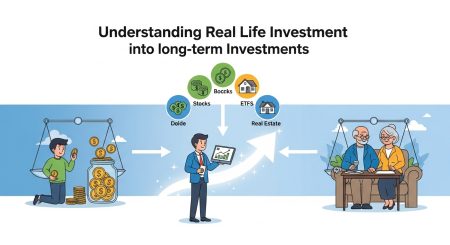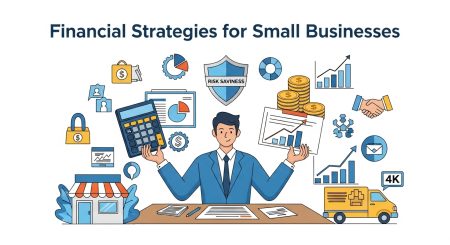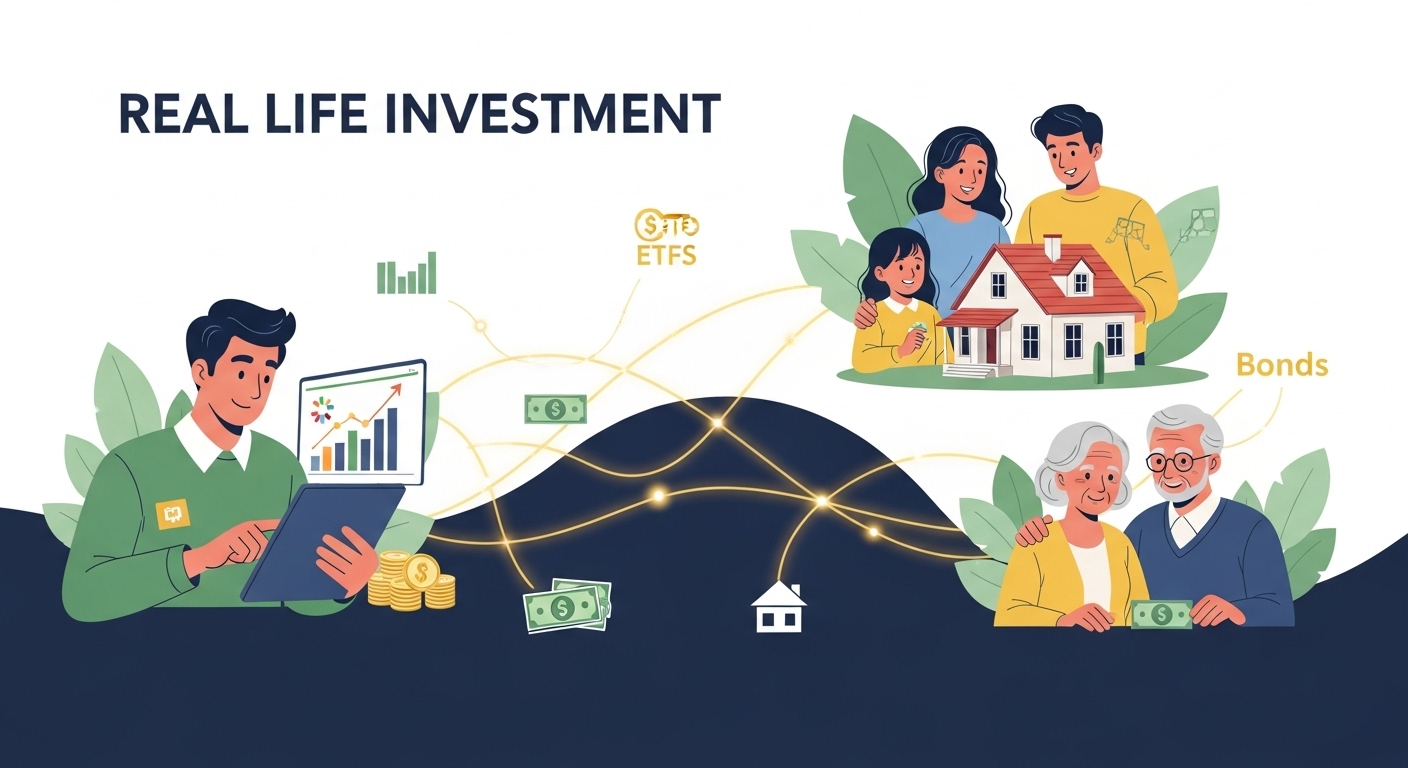Real life investment is about more than just putting money in stocks or property. For founders, marketers, and small business owners, it means making smart decisions daily that grow your business and skills.
Whether you’re adjusting your marketing budget, investing time in employee training, or choosing the right tools, each choice can shape your future success.
This post gives you practical ways to invest your time, money, and skills directly into your business’s growth. You’ll see how everyday decisions push you closer to your goals.
Backed by real examples and actionable tips, you’ll learn how to put every resource to work in ways that truly pay off.
If you’re seeking inspiration from successful entrepreneurs who took calculated risks and won, don’t miss these global entrepreneurial success stories.
Understanding Real Life Investment

Real life investment isn’t just about putting cash into stocks, bonds, or real estate. It’s about practical decisions that have a clear and direct effect on your business and your personal growth.
Founders, marketers, and small business owners succeed not by following the crowd, but by investing in the essentials that drive business value.
This means building skills, shaping your brand, developing products, managing money wisely, and growing key relationships.
Definition and Core Areas
Real life investment means committing your energy and resources to things you can shape, use, and control. Unlike the abstract nature of stock market bets, these investments provide feedback and improvement you can actually see.
The core areas for effective real life investment include:
• Education: Upskill yourself or your team with targeted learning, training, and the latest courses. Knowledge pays the highest dividends.
• Product: Invest in the research, development, and tuning of your products or services. A better product opens doors and builds reputation.
• Brand: Allocate resources to create trust, recognition, and authority for your business, online and offline.
• Cash Flow: Monitor, forecast, and optimize where your money goes. Healthy cash flow lets you invest when it matters most.
• Networks: Build personal and professional connections. The right people extend your reach and bring in new opportunities.
Savvy founders learn these areas are tightly connected. For example, investing in professional relationships can open access to fresh talent, better suppliers, or even new markets.
If you want to see more examples of how founders put these concepts into action, check out these Shark Tank startup lessons for practical insights on pitching, risk management, and scaling.
Why It Beats Traditional Market Returns
While markets can bring quick wins or sudden losses, investing in your own business basics brings stability and often higher long-term returns.
Tangible investments, education, control of cash flow, and team development, reduce risk because you set the pace and control the direction.
Entrepreneurs who invest in their core business areas typically see:
• Stronger customer loyalty (thanks to better products and brands)
• Steadier cash flow (through smart management and repeat sales)
• Growth from referrals and networks (strong relationships bring lasting value)
• Faster adaptation to market changes (due to continuous learning and skill upgrades)
In comparison, traditional portfolios can leave you waiting and worrying about variables you can’t influence. That’s not to say financial assets have no place.
In fact, tools like registered retirement savings plans (RRSPs) can be a smart piece in your overall plan. If you want a detailed review of how one such platform fits into a real life investment strategy, read the Nest Wealth RRSP review Canada to see how it supports business owners looking to strengthen their financial future.
Balancing real life investments with selective financial tools puts you in the driver’s seat. You control the direction, timing, and results, and that confidence is worth more than any quarterly market report.
Everyday Investment Opportunities for Founders

Founders make investment decisions every day, even when they don’t realize it. Not all investments require cash upfront.
Many of the most powerful growth moves start with time, attention, and resourcefulness. Below are practical ways to invest in your business and yourself for future growth and stability.
Investing in Skills and Education
Boosting your knowledge is one of the safest bets there is. In 2025, companies with a focus on employee training saw 218% higher income per employee and were 17% more productive than those without formal training programs.
It isn’t just about formal classes. Free or low-cost online learning, mentorship, and industry events can be just as impactful.
Founders can tap into:
• Free online courses: Try platforms like Coursera, edX, or LinkedIn Learning for relevant, current content. Pick subjects like AI, storytelling, digital marketing, or finance.
• Mentorship: Reach out to industry veterans, local business owners, or alumni groups. A 20-minute call with the right person can save months of trial and error.
• Conferences and workshops: Many now offer virtual options with scholarships or reduced fees for startups.
Continuous learning helps reduce risk. You’ll recognize new opportunities, adapt faster, and avoid missteps. If you want to see more options and ideas for building high-value skills, check out these most marketable skills you can learn online.
Building a Minimum Viable Product (MVP)
Creating an MVP is a smart way to invest effort for maximum return. Instead of spending months and lots of money designing a perfect product, you bring a basic version to the market and gather real feedback early.
Follow this simple MVP framework:
• Identify the core problem you want to solve.
• List the smallest feature set that addresses this problem (skip the fluff).
• Build or prototype only those essentials, even if it’s a slideshow or simple webpage.
• Invite users to test and give feedback.
• Use what you learn to refine and build version two.
An MVP validates ideas before heavy investment. It keeps you nimble, catches issues early, and lets data—not opinions—drive the next version. For a deeper overview and actionable tips, see the complete digital product development lifecycle overview.
Leveraging Customer Feedback
Every founder should think of customer feedback as both a reality check and a growth asset. Customers notice things you’ll miss.
Setting up reliable feedback loops helps you improve your product or service without burning through cash.
Easy ways to harness feedback include:
• Simple surveys: Use tools like Google Forms or Typeform. Ask focused, short questions after purchase or demo.
• Beta testing: Invite a handful of trusted users to use your MVP in exchange for honest input.
• Regular check-ins: Block time each week to review support emails and social media comments for trends.
To act on insights, log feedback in a shared document and review with your team. Prioritize fixes or features that come up often.
This habit fuels better products and higher retention rates. Want tips on understanding what really drives buying decisions?
Explore these efficient ways to understand customer emotions, including practical techniques for reading feedback and adjusting your approach.
These day-to-day moves may seem simple, but they are the foundation of sustainable, compounding business growth.
Financial Strategies for Small Businesses

Smart financial choices create staying power for small businesses. Whether you’re just launching or looking for your next growth step, your approach to handling money could be the difference between steady progress and daily stress.
Founders who understand the real-life tools for building, protecting, and growing capital keep their businesses nimble, resilient, and ready for new chances.
Bootstrapping vs External Funding
Bootstrapping means building your business with personal savings and operating profits. You call the shots, set the pace, and learn to stretch every dollar.
External funding, such as angel investments or venture capital, gives you a larger pot of money upfront, but often comes with some loss of control or added pressure.
Bootstrapping Pros:
• Full ownership and control
• Fewer outside expectations
• Heightened focus on real sales and expenses
Bootstrapping Cons:
• Slower growth
• Limited by personal capital
External Funding Pros:
• More runway for rapid growth
• Added expertise and networks from investors
External Funding Cons:
• Shared ownership and possible loss of control
• Investor expectations and deadlines
The TV show Shark Tank provides real examples of both strategies. Some entrepreneurs pitch for investment after tough bootstrapping phases.
Others skip external cash, relying on tested products to drive organic sales growth. Businesses that understand when to say no to outside funding often show better risk management and adaptability.
Find more insights about risk-aware startup growth from these startup lessons from Shark Tank.
For more options, small business owners exploring ways to raise funds should review the variety of startup capital sources for bootstrappers that can fit both conservative and ambitious plans.
Cash-Flow Management as Investment
Tight cash-flow control isn’t just about survival, it’s also fuel for growth. By carefully tracking income and expenses, you unlock more working capital for strategic moves and avoid getting caught off guard by slow sales seasons or large bills.
Start with a simple budget. List every regular expense and all income streams. Choose a cloud-based accounting tool, Google Sheets, or even pen and paper, whatever you use, check it weekly to avoid costly surprises.
For a brother detail about Cash-Flow Management, read, What is cash flow and why is it important?
Some proven cash management habits:
• Monitor receivables: Get paid faster by sending reminders and offering small discounts for early payment.
• Delay major expenses: Defer any outlay that isn’t urgent or doesn’t drive growth.
• Balance inventory: Stock smart, too much ties up cash, too little risks missed sales.
• Negotiate terms: Seek longer payment terms with suppliers and shorter ones with customers where possible.
Budgeting is more than tracking how much money you have, it’s a chance to plan for the future.
Even a small increase in available cash can get you over hurdles or allow for timely investment in new talent, marketing, or product improvement.
Tax-Advantaged Accounts and Savings
Entrepreneurs don’t have to work alone when it comes to protecting their personal wealth. Tools like RRSPs (Registered Retirement Savings Plans in Canada), 401(k) plans in the US, and other tax-deferred accounts let you grow your money while lowering your taxable income.
• RRSP: For Canadian founders, contributions are tax-deductible and investments grow tax-free until withdrawal.
• 401(k): In the US, pre-tax contributions provide an immediate tax break and many plans include employer matching.
• IRAs and SEP IRAs: Self-employed and small business owners can use these for flexible, tax-advantaged retirement savings.
Using these accounts is like putting a shield around your wealth. You protect more of what you’ve earned and prepare for a stable future, even when business cash flow ebbs and flows.
Each dollar saved now means more freedom and confidence when it comes time for big moves or eventual retirement.
Business owners who balance growth with steady personal savings enjoy more peace of mind, and set themselves up for options, both inside and outside their company.
Marketing as a Real Life Investment
Marketing isn’t just a budget line, it’s a growth engine you can shape to build lasting business value. When done right, every dollar and hour spent is an investment that seeds future sales, awareness, and trust.
For founders and small business owners working with limited funds, smart marketing choices deliver real results without draining the bank account.
Let’s highlight some of the most practical, cost-effective ways to treat marketing as a true investment in your business.
Low‑Cost Content Marketing Tactics
Content marketing is accessible even on a small budget. Great content builds brand authority, earns audience trust, and keeps your business top-of-mind, all without huge ad costs.
Here are affordable content ideas to kick off:
• Start a Blog: Share advice, experiences, or customer stories tied to your niche. Frequent, quality posts can drive consistent web traffic and boost SEO.
• Launch a Simple Podcast: Interview local experts, answer industry questions, or spotlight your startup journey. Low-cost gear and free distribution platforms keep barriers to entry low.
• Encourage User Generated Content: Run social media contests, ask customers for photo reviews, or feature top client testimonials. Let your loyal fans sell for you.
• Create How-To Guides or FAQs: Solve common problems or answer pressing questions your audience faces. Evergreen educational content keeps working for you, year-after-year.
• Short Videos on Social Media: Capture behind-the-scenes clips, product demos, or quick tips using just your smartphone.
If you want to supercharge your efforts, consider adding tech that automates writing, idea generation, and social post scheduling.
You can find inspiration in this Small business AI tools overview, which covers free and budget-friendly tech for busy founders.
Data‑Driven Advertising
Running ads without tracking is like driving blindfolded. To treat advertising as a real investment, use analytics tools to monitor performance, track every dollar spent, and pivot quickly when results dip.
Here’s how to get the most from your ad budget:
• Link Ads to Clear Goals: Set objectives like signups, downloads, or sales, and use dedicated landing pages to track each outcome.
• Tap Free Analytics Tools: Google Analytics and Meta Business Suite provide rich details on traffic, demographics, and actions. Regularly check dashboards to identify what works.
• Calculate ROI: Subtract your ad spend from the value of new business each campaign brings. Compare against previous campaigns to measure improvement.
• Test Small, Scale What Works: Run low-budget test ads first. Once something clicks, increase spend gradually instead of gambling big from the start.
• Adjust Quickly: Cut off ads that aren’t working, double down on those converting cost-effectively.
Good data helps you see trends and predict where to put your next marketing dollar. Need more on using analytics to guide your marketing strategy?
This breakdown of Data-driven communication strategies explains how analysis can shape better business decisions.
Partnerships and Co‑Marketing
Pooling resources multiplies your impact and stretches every marketing dollar further. By joining forces with businesses serving the same audience (but not competing directly), you get access to new customers and split costs on joint campaigns.
Effective partnership ideas include:
• Swap Guest Blogs: Write expert content for each other’s sites and link back, expanding each brand’s reach and SEO profile.
• Host Shared Events or Webinars: Partner on a workshop, panel, or free masterclass. Both companies invite their lists, sharing leads and boosting attendance.
• Bundle Products or Services: Create limited-time offers that combine your best-sellers with those of your partner. The joint promotion brings fresh eyes to both brands.
• Share Ad Space or Mailers: Split the cost of digital ads, print flyers, or sponsor a local event together. Each side saves while reaching a bigger pool of potential customers.
The best partnerships are built on trust and mutual benefit, so look for collaborators who share your mindset and audience values.
Investing in strong alliances keeps your business nimble and open to new growth avenues without big cash outlays.
Measuring ROI of Real Life Investments
When it comes to investing in your business or skills, knowing if your effort and money are actually paying off is key.
Instead of guessing, you can track real progress with numbers, tools, and even lessons from founders who’ve made it work.
This section gives you practical ways to measure your ROI, so you can double down on what really moves your business forward.
Key Performance Indicators for Founders
For founders and small business owners, tracking the right KPIs can be a game changer. These metrics show you, in clear terms, how well your investments are performing:
• Customer Acquisition Cost (CAC): This is the average amount you spend to gain a new customer. Lower is better, but watch if quality or support drops as CAC falls.
• Customer Lifetime Value (LTV): Know how much you’ll likely make from a single customer over time. This helps you decide how much you can actually spend to win a customer.
• Skill Acquisition Metrics: If you’re investing in learning, measure your progress with certifications earned, hours spent, or new skills that drive direct business outcomes (like faster project turnaround or higher sales conversion rates).
• Cash-Flow Ratios: Track your operating cash flow versus total revenue. This ratio shows how well your business turns sales into real cash you can use for growth.
Regularly checking these KPIs turns gut feeling into confident decisions. You’ll see exactly where to invest more, and just as importantly, where to cut back.
Tools and Templates
Measuring ROI doesn’t mean hiring a full-time analyst or buying expensive software. Many founders manage their numbers with simple tools that fit any budget.
Here are some proven, user-friendly options:
• Google Sheets or Microsoft Excel: Free spreadsheet templates for tracking KPIs, budgets, or cash flow make it easy to spot trends and gaps. Look for “small business KPI tracker” templates online.
• Notion and Airtable: Great for building lightweight dashboards and tracking learning goals or customer feedback. Both offer generous free versions.
• Wave Accounting: Free software ideal for solo founders needing to monitor income, expenses, and cash flow in real time.
• Score.org Tools: This nonprofit provides free business templates for financial forecasts, break-even analysis, and more.
Set a weekly or monthly review habit so your numbers stay fresh and actionable.
Case Study Snapshot
Real inspiration comes from founders who turned tracking into growth. One standout example from the collection of inspiring entrepreneurial stories of world‑changing founders features a shoe entrepreneur who built her business from a small workshop.
She started with simple spreadsheets to track her CAC, learning quickly that every dollar spent on personalized sales led to three times the LTV compared to general ads.
When cash flow got tight, her spreadsheet revealed it was due to long supplier payment cycles, not poor sales. She used this insight to renegotiate terms; suddenly, she had the capital to run a marketing experiment that doubled her customer base.
Her story shows how watching the right numbers, using basic tools, and staying curious about what moves the needle can power smart decisions and sustained progress. By tracking her investments, and the results, she scaled what worked and fixed what didn’t, step by step.
Conclusion
Treating everyday business decisions as investments builds more than financial security. It sets up lasting growth through smarter skills, stronger brands, and stable cash flow.
The most successful founders and marketers see each action, not just big financial moves, as a real chance to move their business forward.
Start today by picking one area, whether it’s tracking your key numbers, testing a new product idea, or learning a skill that fits your market. Even small action now leads to bigger, long-term gains.
Thank you for being part of the Ideas Plus Business community. Share your next step with us or find more detailed advice on topics like hardware lifecycle management overview to further boost your business investment strategy.

Sharing actionable business tips, strategies, and industry expertise to drive growth and success.

